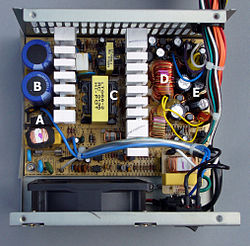स्विच मोड पॉवर सप्लाई
स्विच मोड पॉवर सप्लाई (switched-mode power supply) या एसएमपीएस उन शक्ति-परिवर्तकों (पावर कन्वर्टर्स) को कहते हैं जिनमें पॉवर-कन्वर्शन के लिये किसी स्विच (जैसे आईजीबीटी) को उच्च आवृत्ति पर चालू-बन्द (ON/OFF) किया जाता है। इनकी दक्षता उन कन्वर्टरों से बहुत अधिक होती है जिन्हें रेखीय शक्ति आपूर्ति (लिनियर पॉवर सप्लाईज) कहते हैं जिनमें किसी शक्ति को नियंत्रित करने वाली युक्ति न तो पूरी तरह चालू होती है न पूरी तरह बन्द (अर्थात वह युक्ति ऐक्टिव रीजन में काम करती है)। आजकल उच्च गुणवत्ता वाली स्विचों की उपलब्धता के कारण अधिकांश शक्ति आपूर्तियाँ एसएमपीएस प्रकार की ही निर्मित की जा रही हैं। उच्च दक्षता के अतिरिक्त इनका आकार (साइज) भी समान क्षमता के लिनियर पॉवर सप्लाई से छोटा होता है।

एसएमपीएस के विविध प्रकार (टोपोलोजी)
संपादित करेंआइसोलेशन रहित
संपादित करें| प्रकार (टोपोलोजी)[1] | शक्ति (लगभग) [W] | सापेक्ष मूल्य | ऊर्जा भण्डारण | वोल्टता सम्बन्ध | गुणधर्म |
|---|---|---|---|---|---|
| बक (Buck) | 0–1,000 | 1.0 | एक प्रेरकत्व | 0 ≤ Out ≤ In, | ऑउटपुट में धारा सतत (continuous) होती है। |
| बुस्ट (Boost) | 0–5,000 | 1.0 | Single inductor | Out ≥ In, | इनपुट में धारा सतत होती है। |
| Buck-boost | 0–150 | 1.0 | Single inductor | Out ≤ 0, | Current is dis-continuous at both input and output. |
| Split-pi (or, boost-buck) | 0–4,500 | >2.0 | Two inductors and three capacitors | Up or down | Bidirectional power control; in or out |
| Ćuk | Capacitor and two inductors | Any inverted, | Current is continuous at input and output | ||
| SEPIC | Capacitor and two inductors | Any, | Current is continuous at input | ||
| Zeta | Capacitor and two inductors | Any, | Current is continuous at output | ||
| Charge pump / Switched capacitor | Capacitors only | No magnetic energy storage is needed to achieve conversion, however high efficiency power processing is normally limited to a discrete set of conversion ratios. |
आइसोलेशन प्रदान करने वाली
संपादित करें| प्रकार[1] | शक्ति [W] |
सापेक्ष मूल्य | इनपुट परास [V] |
ऊर्जा भण्डारण | गुणधर्म |
|---|---|---|---|---|---|
| फ्लाईबैक (Flyback) | 0–250 | 1.0 | 5–600 | Mutual Inductors | Isolated form of the buck-boost converter.1 |
| Ringing choke converter (RCC) | 0–150 | 1.0 | 5–600 | Transformer | Low-cost self-oscillating flyback variant.[2] |
| Half-forward | 0–250 | 1.2 | 5–500 | Inductor | |
| Forward2 | 100-200 | 60–200 | Inductor | Isolated form of buck converter | |
| Resonant forward | 0–60 | 1.0 | 60–400 | Inductor and capacitor | Single rail input, unregulated output, high efficiency, low EMI.[3] |
| Push-pull | 100–1,000 | 1.75 | 50–1,000 | Inductor | |
| Half-bridge | 0–2,000 | 1.9 | 50–1,000 | Inductor | |
| Full-bridge | 400–5,000 | >2.0 | 50–1,000 | Inductor | Very efficient use of transformer, used for highest powers. |
| Resonant, zero voltage switched | >1,000 | >2.0 | Inductor and capacitor | ||
| Isolated Ćuk | Two capacitors and two inductors |
अर्ध-अनुनादी शून्य-धारा/शून्य वोल्टेज स्विच
संपादित करेंIn a quasi-resonant zero-current/zero-voltage switch (ZCS/ZVS) "each switch cycle delivers a quantized 'packet' of energy to the converter output, and switch turn-on and turn-off occurs at zero current and voltage, resulting in an essentially lossless switch."[4] Quasi-resonant switching, also known as valley switching, reduces EMI in the power supply by two methods:
- By switching the bipolar switch when the voltage is at a minimum (in the valley) to minimize the hard switching effect that causes EMI.
- By switching when a valley is detected, rather than at a fixed frequency, introduces a natural frequency jitter that spreads the RF emissions spectrum and reduces overall EMI.
इन्हें भी देखें
संपादित करें- पल्स विद मॉडुलेशन (Pulse Width Modulation / PWM)
- रैखिक शक्ति आपूर्ति (लिनियर पॉवर सप्लाई)
- शक्ति इलेक्ट्रॉनिकी
बाहरी कड़ियाँ
संपादित करें- SWITCHING MODE POWER SUPPLY (SMPS) (TOPOLOGIES OVERVIEW, COMPARISON AND SELECTION GUIDE)
- Switching Power Supply Design (Google book By Abraham I. Pressman, Keith Billings, Taylor Morey)
- पॉवर-इ-सिम : सभी प्रकार के एसएमपीएस की ऑनलाइन डिजाइन
सन्दर्भ
संपादित करें- ↑ अ आ ON Semiconductor (July 11, 2002). "SWITCHMODE Power Supplies—Reference Manual and Design Guide" (PDF). मूल से 7 मार्च 2015 को पुरालेखित (PDF). अभिगमन तिथि 2011-11-17.
- ↑ Irving, Brian T.; Jovanović, Milan M. (March 2002), Analysis and Design of Self-Oscillating Flyback Converter (PDF), Proc. IEEE Applied Power Electronics Conf. (APEC), पपृ॰ 897–903, मूल (PDF) से 9 जुलाई 2011 को पुरालेखित, अभिगमन तिथि 2009-09-30
- ↑ "RDFC topology for linear replacement". मूल से 7 सितंबर 2008 को पुरालेखित. अभिगमन तिथि 29 अक्तूबर 2014. 090725 camsemi.com Further information on resonant forward topology for consumer applications
- ↑ "EDN: Comparing DC/DC converters' noise-related performance". मूल से 23 मई 2016 को पुरालेखित. अभिगमन तिथि 29 अक्तूबर 2014.